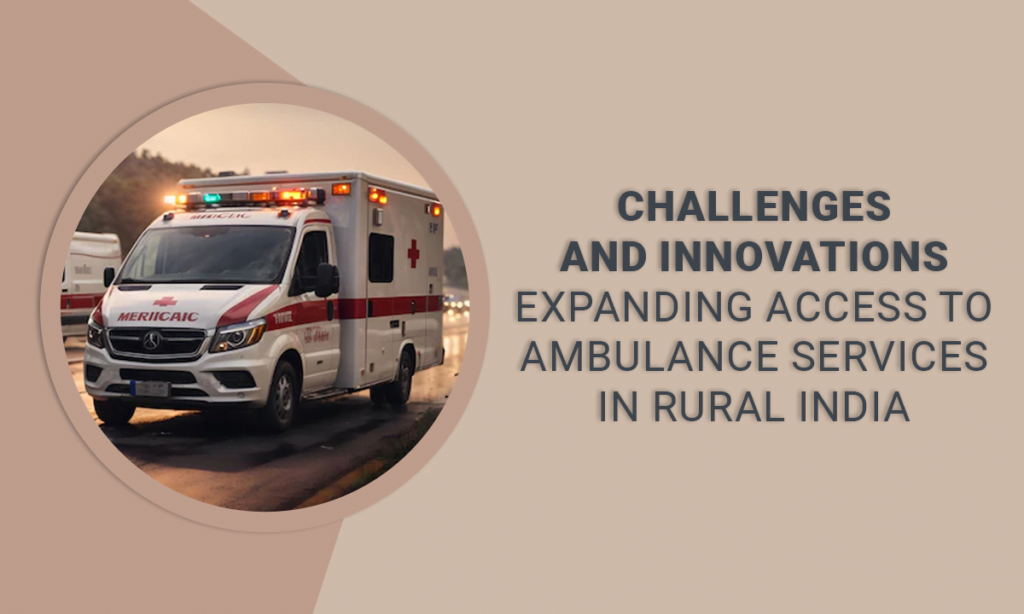In the sprawling rural landscapes of India, where the nearest healthcare facility can be miles away, the availability of ambulance services is not just a convenience but a dire necessity. The disparity in healthcare access between urban and rural areas in India is stark, with the latter often being underserved.
This blog post examines the challenges faced in expanding access to ambulance services in rural India and the innovative solutions that are being implemented to overcome these hurdles.
The Terrain of Challenge: Understanding Rural Healthcare Dynamics
Before delving into the solutions, it’s crucial to understand the unique challenges that rural India faces in terms of healthcare access.
Geographical Barriers
Rural India is characterized by its difficult terrain, which includes remote villages nestled in mountains, forests, and areas with poor road infrastructure. This makes it challenging for traditional ambulances to reach patients in need.
Infrastructure Shortfalls
The lack of adequate healthcare infrastructure means that even when patients are reached and picked up by ambulances, they often have to be transported long distances to reach a facility that can provide the necessary care.
Manpower and Training
There is a significant shortage of trained medical personnel who can provide pre-hospital care in rural ambulances. This shortage is compounded by the limited training opportunities available in rural areas.
Awareness and Cultural Factors
Many rural communities lack awareness about the importance of timely medical intervention. Additionally, cultural factors and reliance on traditional medicine can delay the decision to seek emergency medical care.
Bridging the Gap: Innovations in Ambulance Services
Despite the challenges, there are several innovations aimed at expanding access to ambulance services in rural India.
Motorcycle Ambulances
One of the most notable innovations is the introduction of motorcycle ambulances. These are motorcycles equipped with stretchers and basic medical equipment, designed to navigate narrow and rough terrains to reach patients in areas where four-wheeled ambulances cannot.
Boat Ambulances
In areas such as the Sunderbans in West Bengal, where communities live in remote riverine islands, boat ambulances have been introduced. These ambulances ensure that even those living in the most inaccessible areas can receive timely medical attention.
Community-Based Models
Several states have adopted community-based models where local volunteers are trained in basic life support. These volunteers can provide immediate care and facilitate the transfer of patients to healthcare centers.
Public-Private Partnerships (PPP)
Public-Private Partnerships have been instrumental in augmenting ambulance services. Private entities bring in investments and operational expertise, while the government provides the necessary support and regulatory framework.
The Road to Resilience: Strengthening Rural Ambulance Services
To ensure that the innovations have a lasting impact, it is essential to build a resilient system.
Training and Capacity Building
Investing in the training of local youth and health workers to operate and manage ambulance services can create a sustainable model that is less reliant on external support.
Integrating Technology
The use of GPS technology for tracking and the deployment of telemedicine facilities within ambulances can enhance the quality of care provided en route to the hospital.
Policy Support and Financing
Government policies that prioritize the expansion of ambulance services in rural areas and provide the necessary financing can accelerate the development of these essential services.
Community Engagement
Engaging with community leaders and groups to raise awareness about the ambulance services and the importance of timely medical care can lead to greater utilization and support for these services.
Success Stories: Impactful Outcomes in Rural Ambulance Services
There are numerous success stories that highlight the positive impact of improved ambulance services in rural India.
Decreased Mortality Rates
Regions that have implemented innovative ambulance services have reported decreased mortality rates, particularly in maternal and neonatal cases where timely medical intervention is critical.
Increased Healthcare Utilization
Improved ambulance services have led to an increase in the utilization of healthcare facilities, as communities now have the means to reach hospitals in emergencies.
Empowerment Through Employment
The introduction of new ambulance services has also created employment opportunities for rural youth, particularly as drivers and medical technicians, leading to economic empowerment.
Enhanced Disaster Response
In areas prone to natural disasters, the improved ambulance network has bolstered the capacity for emergency response, ensuring that medical aid reaches affected communities swiftly.
Conclusion: The Journey Ahead for Rural Ambulance Services
The journey to expand access to ambulance services in rural India is fraught with challenges, but the path is being paved with innovative solutions and dedicated efforts. The initiatives undertaken not only aim to provide immediate medical access but also to integrate these services into the larger fabric of rural healthcare.
As we continue to push the boundaries of what is possible, the focus must remain on sustainable models that empower rural communities, leverage technology, and prioritize the health and well-being of the population. The expansion of ambulance services in rural India is not just about vehicles and technology; it’s about building a system that values every life and ensures that no one is left behind in times of medical crisis.
The commitment to improving rural ambulance services is a commitment to strengthening the very heart of India’s healthcare system. It is a promise to ensure that timely assistance is not a privilege but a right for every citizen, regardless of where they live. With continued innovation, investment, and community engagement, the vision of accessible and efficient ambulance services for all can become a reality.
People Also Read: The Visionary Leader: Dr. Ambedkar’s Fight for Dalit Rights and Equality

Pingback: Breaking the Chains of Superstition: Promoting Scientific Thinking in India - Sankalp Bhoomi Trust
Pingback: The Silent Epidemic: Understanding the Menace of Female Foeticide in India - Sankalp Bhoomi Trust